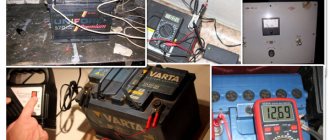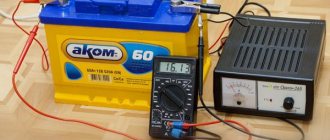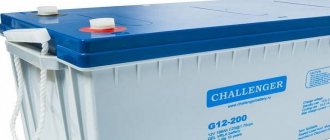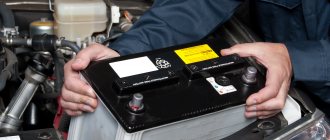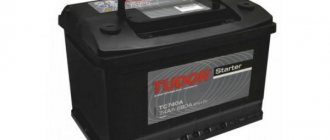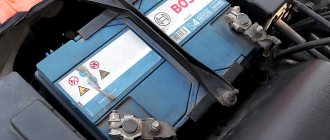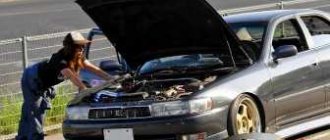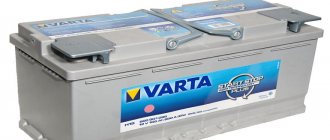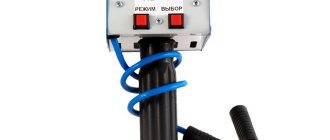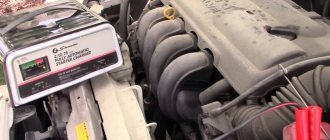In our article we will tell you what chargers should be used to charge motorcycle batteries, how to do it correctly, and what factors will shorten or extend the life of your battery.
It's no secret that motorcycle batteries need to be recharged regularly. Moreover, this procedure must be carried out from time to time even when the battery is removed from the bike and lying quietly at home. On average, this should be done once every month to a month and a half, depending on the level of self-discharge of the battery. In our article we will tell you what chargers should be used to charge motorcycle batteries, how to do it correctly, and what factors will shorten or extend the life of your battery.
How often should you charge your motorcycle battery?
A motorcycle battery needs to be charged when it is completely discharged. Lead batteries require this procedure every 2 months. Power supplies used for more than 2 years are charged once a month. Gel batteries have the lowest self-discharge. It is enough to service them once every 3 months.
After storage, a power source that has been discharged over the winter should be charged immediately. Don't wait until your motorcycle won't start. A critical discharge negatively affects the performance of the battery. A voltmeter is used to monitor the condition of the power source.
Testing is done like this:
- The indicator is set to 20. The red probe is connected to the positive current terminal, the black one to the negative one.
- Evaluate the reading appearing on the tester screen. The normal value is 12.3. When you receive the number 11.2, you need to urgently start charging. A critical loss of energy is indicated by an indicator of less than 11. Recharging in this case may not help.
Types of chargers
Chargers for motorcycle batteries are divided into 2 types:
- Automatic. When using such devices, user control is not required. The control unit regulates the current and voltage throughout the entire cycle. This is convenient in winter when the battery is charged at home.
- Non-automatic. Using such devices, the user is forced to fully monitor the process. This requires a multimeter. In the absence of a tester, the charging progress is monitored visually. The battery is freed from the plugs and the density of the electrolyte is assessed. The main characteristics of budget non-automatic chargers do not differ from those of expensive models.
You need to use the car charger carefully. Car and motorcycle batteries differ in capacity. The former have a higher rate, so the charger supplies a higher current. If such devices are used frequently, the motorcycle's battery may become damaged. The exception is chargers with current characteristics regulators.
Rules and methods for charging a 12 Volt motorcycle battery
When charging a 12 V battery, you must follow the rules to extend the life of the element.
General charging scheme
The general charging algorithm includes the following actions:
- Removing the battery from the socket. The plugs are unscrewed from the battery being serviced. After this, a hydrometer is prepared to measure the density of the electrolyte.
- Charge level assessment. A hydrometer reading of 12.3 g/cm³ indicates full charge. At 50% power recovery, the density is 1.2 g/cm³. With a full discharge, the indicator will be 1.12 g/cm³.
- Connecting the charger. The positive contact is connected to the positive terminal of the battery. Set the desired charging current. If there is no marking, the supplied power should be 10% of the battery capacity. You need to charge the battery until the density of the filler increases to 1.26 g/cm³.
Fast charging
The method involves applying high current. The charge can be restored in a few hours. The procedure resembles standard charging, but the current parameters have maximum values. Before starting the process, make sure the battery is suitable for fast charging.
Manufacturers do not recommend frequently applying high current. The electrodes are damaged, which is why the battery begins to work incorrectly after installation in the motorcycle. Repeatedly exceeding the recommended current parameters leads to an explosion.
Charging an acid battery
The current strength when restoring the charge of such a power source should be 1/10 of the capacity. The desired parameter is set using the regulator. Charging continues until the voltage reaches a value equal to the number of battery cans multiplied by 2. When the charge is restored, bubbles begin to appear on the surface of the electrolyte. Having reduced the current by 2 times, continue charging.
Constant current
The required current power is calculated by dividing the battery capacity by 10. At 6 A/h, 0.6 A is sufficient. This current is obtained using a pulsed device.
Using this method, the motorcycle owner must regularly evaluate the properties of the electrolyte. The current is adjusted every hour. When the voltage increases to 14.4 V, the parameter is reduced by 50%.
Stabilization of voltage and density indicates complete restoration of power.
Charging at a stable voltage
The degree of charge recovery of a 12-volt motorcycle battery is determined by the voltage of the charger. It takes 24 hours for the battery to fully recover. The output voltage should be 16.4 V. The battery is charged automatically, no measurements are needed. 100% charging is indicated by equalization of the voltage at the terminals of the battery and charger.
How to extend battery life?
The service life of the battery is influenced by many factors, in particular, non-compliance with operating rules . This may be too frequent charging or allowing the battery to discharge below the permissible level.
One of the signs of improper battery use is the formation of a white coating on it. This phenomenon is nothing more than lead sulfate. It is formed for a number of reasons, two of which are mentioned above. But there are other factors that contribute to the appearance of plaque:
- battery overheating (above 40 degrees);
- low temperatures with loads on the battery;
- not using a discharged battery for a long time;
- low (below 10.5 V) voltage: the battery under such circumstances can already be disposed of.
To avoid the formation of lead sulfate, you need to regularly check the condition of the motorcycle's electrical system. At the first signs of a white coating, a long (day or more) charging of the battery is required, the current strength should be reduced by half, or even 3 times.
When storing the bike for a long time, which is especially important in winter, it is advisable to store the battery . At home, it will be provided with an optimal temperature, which means that unnecessary discharge will not occur.
In this case, the correct installation and maintenance of the battery must be observed:
- disconnect the battery from the bike, test and recharge, if necessary, after warming up in the apartment;
- It is advisable to store a charged battery at a low temperature to slow down the self-discharge process;
- During the winter we charge the device several times with low current - this compensates for self-discharge.
All this will help extend the battery life and will not lead to adverse consequences in the spring.
To protect the terminals from the onset of the oxidation process (white coating), cleaning them will help. After which the terminal is firmly attached and lubricated with lithol, grease or technical petroleum jelly, you can also use acid-resistant mastic.
In order for the battery to serve for a long time and properly, there are basic rules for its maintenance . They are as follows:
- It is necessary to regularly check the density and level of the electrolyte.
- Store in winter at optimal temperatures. Cold rooms (garage, attic) are not suitable for this.
- If the charger does not have smooth current regulation, it is not suitable for a motorcycle battery. The charging current of a motorcycle battery should be 1/10 of its capacity (amp-hours).
To prevent the electrolyte from spilling out and getting on the frame or other parts of the motorcycle, insert the battery into a rubber or plastic box, the edges of which will be slightly higher than the battery.
There are several ways to charge a discharged or restore a completely dead motorcycle battery. It is best to charge according to the manufacturer's requirements using a special charger. Emergency charging methods are acceptable, but their frequent use will inevitably lead to a decrease in battery life.
How to charge a gel battery for a scooter
- Do not completely discharge the power source. You need to start the procedure when the battery is in good working order. Otherwise, the battery capacity may decrease. Gel batteries function normally at 20% charge.
- Always monitor your charge level. A multimeter is used for this.
Gel battery - charging and maintenance
This type of battery is recharged using a special device. A car charger is not suitable for this purpose. During the procedure, the voltage supplied to the battery is monitored.
This parameter should not be more than 14.4 V. If this rule is violated, the gel filler turns into gas and comes out. Adding electrolyte is not possible. Charging can be done anywhere.
Charger
To restore the charge of the gel battery, a charger with a voltage regulator is used. Before starting the procedure, the value is set at 10% of the battery capacity. The latter can be found on the body of the product.
How long to charge a gel battery for a scooter
You can achieve 100% power recovery after 12 hours.
How to charge a motorcycle battery quickly
Accelerated charging can shorten the service life of the power source and lead to sulfation of the plates, therefore motorcycle equipment manufacturers do not recommend resorting to artificially shortening the charge time of the drive. For accelerated charging, high current parameters are used; if used constantly, the battery will no longer be able to be fully charged using a generator. Before you start, look at the case and in the instructions to see if the unit supports accelerated charging mode.
Which factors shorten and which extend battery life?
The following factors can reduce battery life:
- Frequent full discharges and charges. The first sign of element failure is a light coating.
- Overheat. If the case temperature reaches 50°C, the likelihood of failure increases.
- Operation in frosty weather.
- Long-term storage in a discharged state. When the voltage drops to 10 V, the battery can be disposed of.
The service life is extended by reducing the output voltage to 0.3 A. The charging duration increases to 24 hours, but the loss of capacity is reduced.
How to charge a motorcycle battery?
We will answer the main 4 questions:
1. When should you charge your motorcycle battery?
2. How should you charge your motorbattery?
3. How to charge the battery?
4. And how long does the charging process take?
1. When to charge?
When tested, a charged 12-volt battery will show a voltage of 12.7-12.8 volts.
If a motorbattery rated 12 Volts shows a voltage of 12.5 V, the battery is 20% discharged, if the voltage is 12.2 V, the battery is 50% discharged. The battery needs to be recharged. A completely discharged battery will show a voltage of 11.7 Volts or lower.
2. How should you charge your motorbattery?
To charge a motorcycle battery, use a special charger designed for motorcycle batteries.
Chargers designed for cars are not suitable for motorcycles and other motor vehicles. The voltage in them is higher than that required for a motorcycle battery, which leads to overcharging of the battery.
Use an automatic charger with voltage regulation and stabilization function.
3. How to charge the battery?
When charging the battery, follow the rule: the current should be equal to 10% of the battery capacity. Set the required value on the corresponding regulator of the charger. That is, if you have a 9 Ah battery, then it should be charged with a current of 0.9A.
1. If the battery is serviceable, remove the plugs from the filler holes.
2. Connect the charger to the battery, observing the polarity.
3. First connect the positive wire to the + terminal of the battery;
4. Then connect the negative wire to the battery .
5. Set the charging current.
6.Adjust the battery charging voltage. For all types of WET, AGM, GEL batteries, the charge voltage should be at the level of 14.0-14.1 Volts.
7. Connect the charger to the mains.
4. How long does it take to charge?
Using an automatic charger, upon completion of recharging, the device indicator will display information about the end of the battery charge.
The battery is considered fully charged if the charging voltage and current remain unchanged for 1-2 hours.
Visually determining the full charge of the battery is possible only in serviced batteries. When bubbles appear on the surface of the electrolyte in the jars, the battery is considered charged.
A complete charging cycle for a motorcycle battery takes about 10-12 hours.
The degree of charge of the battery can also indicate the density of the electrolyte.
How to properly charge a 12-volt maintenance-free battery
Let's take a little more detail on charging a 12-volt sealed (maintenance-free) battery with a non-automatic charger. After connecting it to the terminals (observing polarity, of course), the minimum current strength is set to the charger. After this, the charger can be plugged into a power outlet. To charge the battery normally, we need a current of one tenth of the battery capacity. That is, with a capacity of 30A/h we set the current to 3 amperes. In the future, the ammeter will have to be regularly monitored, since the current strength will change naturally and will need to be returned to the required value.
In this form, charging should occur until the voltage reaches 13.8 volts (a voltmeter is used for measurement). After this milestone, we reduce the current to the charger by about a third (for example, from 3 amperes to 2). And again we catch up to 13.8 volts. Then we repeat the same procedure with the current reduced by half (in our case, from 2 to 1 ampere). After this, the charger can be turned off. Typically, a full charging cycle for a 12-volt motorcycle battery takes about 10-12 hours.
HOW TO CHARGE A MOTORCYCLE BATTERY
- recharge and check with a voltmeter whether the voltage is within 12.8-13 volts,
- determine the remaining battery capacity using a load plug or charger,
- Determine the remaining battery capacity using a fixed load. Knowing the current consumption of the load, we can find out the time it will be able to pull this load.
Example: capacity 12 A/h. This means that within an hour it should produce a current of 12A. Within 2 hours 6A, within 4 hours 3A. And so on
It is best to charge the battery with a current of 10% of the rated capacity for 10 hours, i.e. A battery with a capacity of 12A/h is best charged with a current of 1.2A.
But in general, it makes sense to look at the recommended charging current on the battery cover/box, plus, some batteries can be charged in accelerated mode within an hour with a current of half the capacity.
How often should you charge your motorcycle battery?
The battery is charged as it is discharged. For conventional lead-acid batteries, the recharging frequency is one and a half to two months, and sometimes less (if the battery is old and worn out). Gel batteries for motorcycles can be recharged less frequently. It is enough to do this once or twice a season.
It is important to understand that the battery has a certain level of self-discharge, even when disconnected. This is especially true for the cold season, when most motorcyclists put their bikes in the garage and bring batteries home.
Don't put off recharging until your motorcycle won't start in the morning. This could lead to excessive discharge, which could lead to irreparable consequences for the battery. To avoid such an unpleasant situation, it is enough to check the battery condition with a voltmeter from time to time.
To do this, you need to set the device readings to 20 volts and attach the red probe to the positive of the battery, and the black one to the negative. If the device shows:
- 12.3 volts - everything is fine, don’t worry about it for now;
- a mark in the range from 11 to 12.2 volts indicates that it is time to charge the battery;
- readings less than 11 volts are very alarming. This means that the battery urgently needs to be charged, but this may not save it.
Motorcycle battery condition testing
In order not to miss the moment, you should constantly check the charge level using a special device - a voltmeter.
- We set the indicator to 20 Volts, connect the red probe to (+), and the black one to (-) and watch the readings.
- A value of 12.3 indicates the norm - continue using lightweight vehicles.
- If the indicator is below normal, but above 11, it’s time to charge the power source.
- 9-11 is an indicator of a critical condition; urgent charging is required, but be prepared for the fact that it may not help.
- Below 9 – the battery should be replaced with a new one.
Types of Motorcycle Battery Chargers
Chargers for motorcycle batteries are divided into more expensive automatic and conventional ones, which require additional control. The first ones require virtually no intervention on your part. You simply connect it, and the electronic control unit will independently set the required current strength and control it until the very end of recharging. This function is especially convenient when wintering the battery in an apartment.
Cheap chargers can also charge your battery quite effectively. But the charging process will need to be constantly monitored, for which you will need a multimeter. If you do not have such a device, you can use visual observation. To do this, you will have to unscrew all six caps from the battery and monitor the electrolyte. You will find the details of this procedure below.
To charge the gel battery you will need a special charger. The range of such devices on the Internet is now rapidly growing, so choosing the appropriate device will not be difficult. Let's just say that chargers for gel batteries are also divided into automatic and non-automatic. And their cost depends on the set of functions.
Particular attention should be paid to attempts to charge a motorcycle battery with a car charger. The fact is that the capacity of car batteries is much higher than that of motorcycle batteries. Therefore, chargers for them produce much more current than we need. Thoughtless use of car chargers will lead to premature failure of your battery. A car charger can charge a motorcycle battery only if it has a current regulator. Only after making sure that you can get 10% of your battery's current amperage should you charge your motorcycle battery with a car charger. If you are a beginner, it is better not to take risks.
Tips for properly charging your motorcycle battery
First tip for beginners. If you are convinced that your battery requires charging, sketch out the wiring diagram before removing it from the motorcycle. This diagram will come in handy when you put it in place.
Make sure the battery is at room temperature before charging. It's also worth checking to see if there are any open flames or sparks nearby. After this, you can connect the charger, observing the polarity.
Lead-acid batteries must be charged at a current equal to 10% of their capacity. Therefore, using the current regulator, set the required value. In this form, charging should be carried out until the voltage reaches a value equal to the number of battery cells multiplied by 2.4 (for a standard battery, respectively, 14.4). When visually observing the electrolyte (which we wrote about above), this moment will come when gas bubbles begin to form on the surface of the acid. After this, you need to reduce the current by half and charge for another 2 hours.
The gel battery is charged in a similar way. Here you also need to use a current that does not exceed 10% of the battery capacity. The main feature of this process is that the voltage supplied to it should not exceed the threshold. For most gel batteries, this indicator is in the range of 14.2-14.4 V. Well, the second stage of charging with a decrease in current is not required here. Just continue the process until fully charged. This usually takes about 10 hours.
And one more useful tip. If you have over-discharged your battery (it doesn’t matter whether it’s lead or gel), you need to revive it with a current half as strong as usual. That is, approximately 5% of its capacity. The charging time will also increase noticeably. If this doesn't help, nothing will help.
General rules for recharging a 12-volt bike battery
Now we will tell you the sequence of actions on how to charge a motorcycle battery with a charger:
- We remove the power source from a lightweight vehicle.
- If the device is serviceable, remove the plugs and prepare the hydrometer. If the unit is maintenance-free, prepare a voltmeter.
- We fill the devices with electrolyte and look at the readings: 1.28 g/cm3 – full battery charge, 1.20 kg/l – half charge, 1.12 g/cm3 – complete discharge.
- Connect the charger to (+).
- Look at what current to charge the motorcycle battery on the packaging or the battery itself and set the desired current.
- If there is no marking, then use a current equal to 10% of the capacity, constantly measure the level of electrolyte density.
How often should you charge your motorcycle battery?
Charging is mandatory if the battery component begins to produce insufficient inrush current. Some types of batteries, such as lead-acid batteries, need to be recharged every 2 months. Gel batteries lose their charge more slowly.
They are charged every 3-4 months. A battery that has been stored for a long time is charged before installation. Deep discharge will result in reduced capacity or product failure, so servicing should not be delayed until your motorcycle no longer starts.
Types of chargers
To restore the charge of motorcycle batteries, the following types of devices are used:
- Simple. The required characteristics of the electricity supplied by the devices are specified by the user. It is necessary to constantly monitor the condition of the product using a universal tester. If a multimeter is not available, remove the plugs and measure the density of the acid solution. Other characteristics of a simple charger are not much different from the properties of more expensive models.
- Automatic. In this case, the device itself
Automatic charger for motorcycle.
controls the process by choosing appropriate parameters. Automatic devices are well suited for restoring the power of motorcycle batteries at home.
- Automotive. They are rarely used, which is explained by the difference in battery capacities for cars and motorcycles. An automobile charger produces high current, which leads to boiling of the electrolyte and destruction of the plates. Batteries charged with such devices often become unusable. Car chargers can be used if they have a parameter adjustment function.
Rules and methods for charging a 12-volt motorcycle battery
Correct selection of the basic parameters of the supplied electricity and procedure time helps to avoid battery damage.
General charging scheme
Using any charging method involves performing the following actions:
- Dismantling the battery. The device is removed from the engine compartment. The plugs are removed from the top of the housing. Measure the density of the acid solution using a hydrometer.
- Determination of charge level. The electrolyte density of a fully charged battery is 1.23 g/cm³. If the charge is reduced by 50%, the hydrometer will give a reading of 1.2. At a critical discharge, a smaller number appears.
- Connecting the charger. Polarity must be observed.
- Selecting the required current strength. If the instructions do not indicate recommended readings, set 10% of the nominal battery capacity.
- Charger. The process is continued until the electrolyte density increases to 1.25.
Motorcycle battery charging diagram.
Fast charging
The process accelerates when a powerful current is applied. The procedure for performing the actions does not differ from that for standard charging, however, the duration of the procedure is reduced to 6 hours.
Before connecting the charger, make sure that accelerated charge recovery is not contraindicated.
It is not recommended to use the method too often. The electrodes begin to crumble, causing the capacitance to decrease or a short circuit to occur. Sometimes the wrong choice of parameters leads to rupture of the case.
Charging an acid battery
To restore battery power, a current of 0.1 *C is supplied, where C is the rated power of the battery. To select a value, use the lever located on the charger body.
When the voltage reaches levels equal to the number of battery cans multiplied by 2, active gas formation begins. This indicates the need to reduce the power of supplied electricity by 50%.
Constant current
To calculate the current, you need to divide the battery capacity by 10. For example, for a battery with a capacity of 60 Ah, this parameter will be 6 A. Constant electricity is obtained using an automatic charger.
The device constantly maintains the required current power and monitors the voltage. When fully charged, the current supplied by the charger decreases sharply.
Charging at a stable voltage
The charging time of a 12-volt battery depends on the voltage supplied by the charger. When supplying 16.4 V, this process will take 24 hours. The charge is restored automatically. There is no need to monitor the electrolyte condition. When the voltage at the terminals of the charger and battery is equalized, the procedure is stopped.
Using a current stabilizer
The introduction of this device into the electrical circuit prevents the electrolyte from boiling or the destruction of the plates. If the voltage increases sharply, the electrodes close. The battery stops gaining charge. The stabilizer equalizes the voltage, preventing overcharging. The current power when using this method is 0.05 *C.
Pulse current
Pulse chargers supply electricity with variable strength and voltage. Indicators change at certain intervals. When applying symmetrical current, the polarity is reversed in each cycle. When pulsating current is applied, the voltage and strength increase at different intervals.
Charging a maintenance free battery
The process is not much different from charging a serviced battery. However, the current power should not exceed 10% of the battery capacity. When connecting the charger to the battery terminals, observe the polarity. During the procedure, parameters are not allowed to increase. If this happens, the indicator is adjusted. The charge level is assessed by the voltage at the terminals.
How to revive a dead battery?
Before you start reviving a completely dead battery, you need to find out the possible reasons for its failure.
Electrolyte boils when charging
If this is observed in one of the sections, then in all likelihood a short circuit of the plates has occurred. In this situation, instead of charging the battery, rinse the jar with distilled water. Do the procedure until all the coal chips disappear. Then bring the electrolyte in the battery to the required density and charge it.
If this method turns out to be useless, then the battery will no longer be of any use: with a closed battery, one conversation - to the landfill. Alternatively, you can mechanically close the plate (in road conditions) to get home.
Reducing battery capacity to zero
Most likely the battery plates have become sulfated. To revive a motorcycle battery, you need to stock up on:
- distilled water;
- nominal (1.28 g/cc) electrolyte density;
- hydrometer - a device that measures the density of the electrolyte (small devices are available for motorcycles);
- a charger with adjustable current;
- to the electrolyte - a desulfating additive.
As a rule, the process of cleaning battery plates is described in the instructions, but the key points are as follows:
- Fill the battery with electrolyte.
- We add an additive to the jars (there are also those that are added before filling).
- We expect it to dissolve in the electrolyte within 48 hours.
- We carry out a cycle of running the battery: we charge and immediately discharge the battery (we use the brake light lamp for this, but not the bike starter).
The discharge process should be continued until the voltage is at 10 volts. The cycle must be repeated until the nominal density of the electrolyte in the battery is reached.
The battery being serviced must have a special tube that will facilitate the removal of gases and condensate during operation. It should extend outside the bike and not close.
How to charge a gel battery for a scooter
A gel battery cannot be allowed to be deeply discharged. Recharging begins when the power decreases to 20%. The charge level is determined by measuring the voltage at the terminals.
Gel battery for scooter.
Gel battery - charging and maintenance
Such a battery is charged only with a device designed to restore the power of motorcycle batteries. The process is accompanied by regular measurement of the voltage produced by the charger. This indicator should not exceed 14.4 V. Otherwise, during many hours of charging, the gel will turn into a gaseous state. It will not be possible to return the electrolyte to its previous consistency.
Charger
It is recommended to use a charger that allows you to regulate the voltage. In addition, there must be a power regulator.
How long to charge a gel battery for a scooter
The average duration of a standard procedure is one day.
How many hours does it take to charge a 12 volt battery?
Conclusion
| Density level of electrolytic liquid in battery banks, g/cm3 at a temperature of 15 degrees Celsius | Voltage, Volt (without operating voltage) | Recharging time using constant voltage method, h to 100% |
| 1,190 | 12,180 | At least 16 |
| 1,200 | 12,240 | At least 14 |
| 1,210 | 12,300 | At least 12 |
| 1,220 | 12,360 | At least 10 |
Which factors shorten and which extend battery life?
The following reasons contribute to premature battery failure:
- Bringing the power source to a critical level. This factor leads to accelerated sulfation of the plates, due to which the battery ceases to hold a charge.
- Overheat. Do not allow the housing to heat up to a temperature exceeding 50 °C.
- Use at extremely low temperatures.
- Store in a completely discharged state. If the voltage drops to 9 V, the battery cannot be restored.
Battery life will be extended by slow charging, proper condition of the motorcycle's major components, and regular maintenance.
What causes a battery to fail?
If the motorcycle is regularly maintained, the battery is recharged slowly and the components are in good condition, the device will last a long time and does not require frequent recharging, but in practice it is not always possible to follow these rules.
Here is a list of factors that have the most negative impact on the wear resistance of a bike’s battery:
- Regular complete discharge of the power supply. If the owner constantly misses the right time to recharge, accelerated sulfation of the plates occurs and the device ceases to hold a charge.
- Overheating of the case or operation at extremely low temperatures - both extremes quickly damage the battery.
- Long-term storage in a discharged state. If you don’t measure the voltage level in time and lay the bike up in this condition, with the onset of the new season you will have to buy a motorcycle battery.
If you ensure timely and correct recharging, avoid overheating of the case and use in extremely low temperatures, the motorcycle power supply can last a long time.

